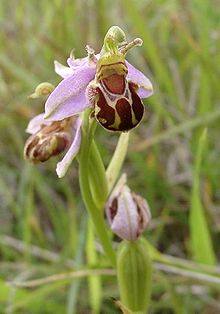
Dactylorhiza is a genus of flowering plants in the orchid family Orchidaceae. Its species are commonly called marsh orchids or spotted orchids. Dactylorhiza were previously classified under Orchis, which has two round tubers.

Ophrys lutea, the yellow bee-orchid, is a species of orchid native to southern Europe, North Africa, and the Middle East, the range extending from Portugal and Morocco to Syria.

Pseudocopulation describes behaviors similar to copulation that serve a reproductive function for one or both participants but do not involve actual sexual union between the individuals. It is most generally applied to a pollinator attempting to copulate with a flower. Some flowers mimic a potential female mate visually, but the key stimuli are often chemical and tactile. This form of mimicry in plants is called Pouyannian mimicry.

Orchis is a genus in the orchid family (Orchidaceae), occurring mainly in Europe and Northwest Africa, and ranging as far as Tibet, Mongolia, and Xinjiang. The name is from the Ancient Greek ὄρχις orchis, meaning "testicle", from the appearance of the paired subterranean tuberoids.

Ophrys insectifera, the fly orchid, is a species of orchid and the type species of the genus Ophrys. It is remarkable as an example of the use of sexually deceptive pollination and floral mimicry, as well as a highly selective and highly evolved plant–pollinator relationship.
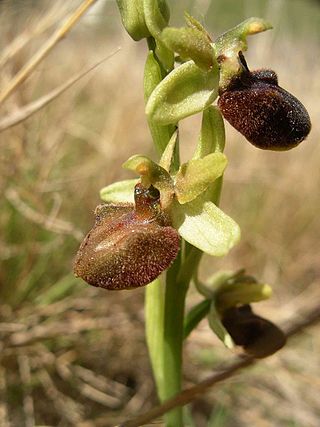
Ophrys sphegodes, commonly known as the early spider-orchid, is a species of sexually-deceptive orchid native to Europe and the Middle East. It is a very varied species with many subspecies recognised.

Dactylorhiza maculata, known as the heath spotted-orchid or moorland spotted orchid, is an herbaceous perennial plant of the family Orchidaceae. It is widespread in mountainous regions across much of Europe from Portugal and Iceland east to Russia. It is also found in Algeria, Morocco, and western Siberia.
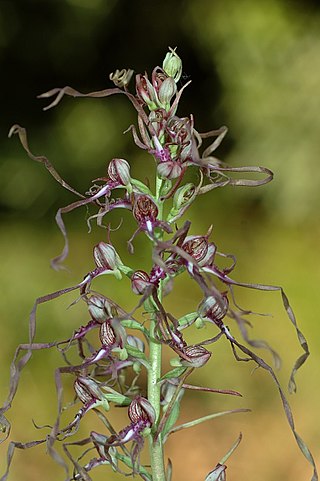
Himantoglossum is a genus of orchids native to the Canary Islands, Europe, southwest Asia and northern Africa. Its members generally have a labellum which is divided into three parts, of which the middle part is the longest.

Dactylorhiza romana, the Roman dactylorhiza, is a species of orchid. It is native to the Mediterranean Region of southern Europe and northern Africa, the range extending eastward to Iran and Turkmenistan.
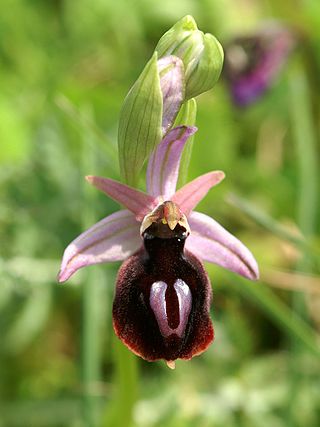
Ophrys ferrum-equinum, the horseshoe bee-orchid, is a terrestrial species of orchid native to Albania, Greece, and Turkey, including Crete and other islands of the Aegean. It owes its species name to the characteristic shape of a silver horse-shoe on the brown petal.
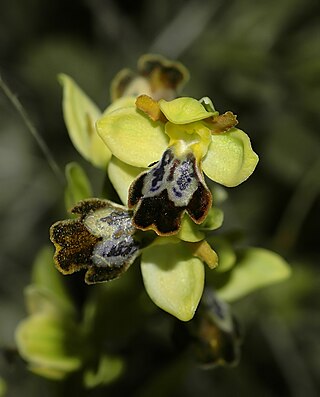
Ophrys fusca, commonly known as the sombre bee-orchid or the dark bee-orchid, is a species of orchid native to the Mediterranean from southwestern Europe and northern Africa to western Asia. Most subspecies of the Ophrys fusca are pollinated by males Andrena bees.

Ophrys omegaifera, the omega bee-orchid, is a species of orchid native to the Mediterranean region from Portugal and Morocco to Syria.

Ophrys reinholdii is a species of orchid. Its native range from Croatia in southeastern Europe to northwestern Iran in western Asia, including Bulgaria, Greece, Turkey and Cyprus.

Ophrys umbilicata is a species of orchid found from Albania to Iran, including Greece, Israel, Lebanon, Turkey and Cyprus.
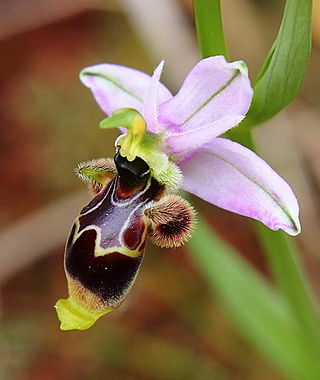
Ophrys scolopax, known as the woodcock bee-orchid or woodcock orchid, is a species of terrestrial orchid found around the Mediterranean and the Middle East, from Morocco and Portugal to Hungary and Iran.

Ophrys argolica, the late spider orchid, or Argolian bee-orchid, is a terrestrial species of orchid native to Greece, Italy, Croatia, Cyprus, Turkey, Lebanon and Syria. The epithet "argolica" refers to the Argolia region of Greece, southwest of Athens.

Ophrys kotschyi, the Cyprus bee orchid, is a terrestrial species of orchid native to Greece and Cyprus.

Ophrys speculum, the mirror orchid, is a species of Ophrys distributed throughout the Mediterranean that is pollinated exclusively by a single species of scoliid wasp.

Ophrys sphegodes subsp. taurica, with many synonyms, including Ophrys caucasica, is a subspecies of orchid native from southeast Europe through the Caucasus to Iran. As Ophrys caucasica, it has been recorded in numerous areas throughout Armenia, Azerbaijan, Georgia and Russia. Local names include Armenian: Սարդակիր Մեղվակիր, romanized: Sardakir mexvakir, Azerbaijani: xarı-bülbül and Georgian: ფუტკრის-დედა, romanized:put'k'ris-deda.

Ophrys holosericea, the late spider orchid, is a species of flowering plant in the family Orchidaceae, native to western and central Europe and the Mediterranean region. There has been considerable confusion about the identity of this species and the correct spelling of its name.
